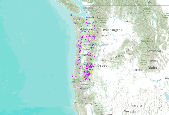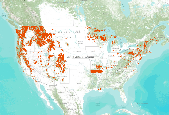Filters: Tags: Health (X)
288 results (13ms)|
Filters
Date Range
Extensions Types
Contacts
Categories Tag Types
|
The Blueprint 2.2 Data Download is a .zip file containing all of the spatial data associated with the Blueprint 2.2.
Categories: Data;
Types: Map Service,
OGC WFS Layer,
OGC WMS Layer,
OGC WMS Service;
Tags: Data,
Data.gov South Atlantic Landscape Conservation Cooperative,
LCC Network Science Catalog,
biota,
biota,
This EnviroAtlas web service supports research and online mapping activities related to EnviroAtlas (https://www.epa.gov/enviroatlas). The Clean and Plentiful Water category in this web service includes layers illustrating the ecosystems and natural resources that filter and regulate water, the need or demand for clean and plentiful water, the impacts associated with water quality, and factors that place stress on water quality and supply. EnviroAtlas allows the user to interact with a web-based, easy-to-use, mapping application to view and analyze multiple ecosystem services for the conterminous United States. Additional descriptive information about each attribute in this web service is located within each web...
Benthic diatom assemblages are known to be indicative of water quality but have yet to be widely adopted in biological assessments in the United States due to several limitations. Our goal was to address some of these limitations by developing regional multi-metric indices (MMIs) that are robust to inter-laboratory taxonomic inconsistency, adjusted for natural covariates, and sensitive to a wide range of anthropogenic stressors. We aggregated bioassessment data from two national-scale federal programs and used a data-driven analysis in which all-possible combinations of 2-7 metrics were compared for three measures of performance. The datasets in this release support the Carlisle, et al. 2022 report cited herein....
Categories: Data;
Types: Map Service,
OGC WFS Layer,
OGC WMS Layer,
OGC WMS Service;
Tags: Aquatic Biology,
Ecology,
USGS Science Data Catalog (SDC),
Water Quality,
algae,
These data represent a one-time synoptic survey of sampled soils, pavement dust, and stream sediment in 10 urban watersheds in three regions of the United States (Pacific Northwest, northeast, and southeast) to evaluate sources of sediment and two groups of common urban contaminants: polycyclic aromatic hydrocarbons (PAHs) and metals. Analyses of samples from six of the watersheds included fallout radionuclides to facilitate identification of sediment sources to the streams. Scripts used in R to test selected explanatory variables for the urban contaminants using Generalize Additive Models (GAMs) are included. The data release also includes Geographic Information System (GIS) spatial layers that were developed for...
This EnviroAtlas web service supports research and online mapping activities related to EnviroAtlas (https://www.epa.gov/enviroatlas). The Food, Fuel, and Materials category in this web service includes layers illustrating the ecosystems and natural resources that provide or support the production of food, fuel, or other materials, the need or demand for these items, the impacts associated with their presence and accessibility, and factors that place stress on the natural environment's capability to provide these benefits. EnviroAtlas allows the user to interact with a web-based, easy-to-use, mapping application to view and analyze multiple ecosystem services for the conterminous United States. Additional descriptive...
Using the horizontal-to-vertical spectral-ratio (HVSR) method, we infer regolith thickness (i.e., depth to bedrock) throughout the Farmington River Watershed, CT, USA. Between Nov. 2019 and Nov. 2020, MOHO Tromino Model TEP-3C (MOHO, S.R.L.) three-component seismometers collected passive seismic recordings along the Farmington River and the upstream West Branch of Salmon Brook. From these recordings, we derived resonance frequencies using the GRILLA software (MOHO, S.R.L.), and then inferred potential regolith thicknesses based on likely shear wave velocities, Vs, intrinsic to the underlying sediment. Three potential shear wave velocities (Vs = 300m/s, 337m/s, 362 m/s) were considered for Farmington River watershed...
Categories: Data;
Types: Downloadable,
Map Service,
OGC WFS Layer,
OGC WMS Layer,
Shapefile;
Tags: Connecticut,
Farmington River,
Hydrology,
USGS Science Data Catalog (SDC),
groundwater,
This data release contains the concentration and quality-assurance results for inorganic constituents, as well as organic compounds (volatile organic compounds [VOC], per- and polyfluoroalkyl substances [PFAS], pesticides and disinfection byproducts [DBP]) and microbiological results collected in the Little Big Horn River and residential or commercial tapwater locations in Montana. Twenty-two tapwater samples (six sourced from public supply and 14 sourced from private wells) and six surface-water samples were collected in Montana between August 8-10, 2022. Pharmaceuticals, VOC, and PFAS were analyzed at the U.S. Geological Survey (USGS) National Water Quality Laboratory (NWQL) in Denver, Colorado. Pesticides and...
Categories: Data;
Tags: Environmental Health,
Montana,
USGS Science Data Catalog (SDC),
United States,
Water Quality,
The mule deer (Odocoileus hemionus) of the Pueblo of Santa Ana herds are primarily non-migratory, with two distinct winter ranges separated by U.S. Route 550. The winter ranges consist primarily of Chihuahuan semi‐desert grassland, dominated by black grama (Bouteloua eriopoda), galleta (Pleuraphis jamesii), mesa dropseed (Sporobolus flexuosus), and fourwing saltbush (Atriplex canescens), with higher elevation sections consisting of pinyon-juniper woodland and juniper savannah. There was no movement between the two winter ranges, with only individuals from the winter range northeast of US 550 crossing the highway west of the Jemez Canyon Reservoir. Two individuals from the winter range northeast of US 550 migrated...
Categories: Data;
Types: Downloadable,
Map Service,
OGC WFS Layer,
OGC WMS Layer,
Shapefile;
Tags: New Mexico,
Santa Ana Pueblo,
United States,
animal behavior,
health,
The data presented here are blacklegged tick nymph densities, white-tailed deer densities, and Borrelia burgdorferi (causative agent of Lyme disease) prevalences for eight national parks in the eastern United States from 2014-2022.
Research and surveillance reports have documented a significant increase in coal workers' pneumoconiosis, including the most severe forms of progressive massive fibrosis and rapidly progressive pneumoconiosis in U.S. coal miners, particularly those in Appalachian coalfields. Several possible explanations for these observations include excessive exposures to total respirable dust, increased exposure to freshly fractured silica and silicates, or greater exposure to smaller particles that may be the result of changing mining practices. This dataset contains the chemical and morphological characteristics of particulate matter retrieved from lung tissue slices of historical and contemporary miners.
Categories: Data;
Types: Map Service,
OGC WFS Layer,
OGC WMS Layer,
OGC WMS Service;
Tags: Appalachia,
Environmental Health,
GGGSC,
Geochemistry,
Geology, Geophysics, and Geochemistry Science Center,
The data consist of levels of organic pollutants found in the blue mussels (Mytelus trossulus) samples from 44 sites along the Aleutian archipelago and in Cross Sound in southeast Alaska. For each site, the percent lipid, percent water and the sum of the target organic compounds are reported. The compounds are PCBs (polychlorinated biphenyls), DDTs (dichlorodiphenyltrichloroethanes), HCHs (hexachlorocyclohexanes), chlordane, and HCB (hexachlorocyclobenzene).
The data consist of levels of organic pollutants found in the blood of sea otters captured from five areas in the western aleutian Islands and in Cross Sound in southeast Alaska. For each location, the sample size, and the median and range of values for each compound is provided. The compounds are PCBs (polychlorinated biphenyls), DDTs (dichlorodiphenyltrichloroethanes), HCHs (hexachlorocyclohexanes), chlordane, HCB (hexachlorocyclobenzene), and dieldrin.
Categories: Data;
Tags: Southeast Alaska,
Western Aleutian Islands,
biota,
health,
organic pollutants,
Hydrates in nature have been known for a long time. In the last couple of decades the possibility of commercial utilization of natural hydrates has arisen as an alternative energy source. This paper asks 21 questions that, in the author’s opinion, need to be addressed and answered correctly before one can be confident one understands the scope of the problem one is facing in attempting to address the role of natural hydrates, both commercially and geologically.
Categories: Publication;
Types: Citation;
Tags: drilling,
health,
hydraulic fracturing,
natural gas,
ozone,

This dataset is a compilation of forest insect, disease and abiotic damage mapped by aerial detection surveys on forested areas in the United States. At this time, the National Aerial Survey Data Standards require only mortality and defoliation data be collected and reported. However, many cooperators collect data on other types of damage and therefore, the national database has been designed to accommodate these data. Low-level flights, typically 1,000 to 2,000 feet above ground level, are used to map forest damage. Observers use paper maps, typically 1:100,000 scale USGS maps, upon which they record the damage. There is also a digital sketchmap system that may be used. The digital system uses GPS to display the...
Tax brackets are a common feature of non-renewable resource taxes. Although the introduction of brackets would seem to be an innocuous way of approximating a non-linear tax system, the dynamic effects are surprising. This paper shows that the presence of tax brackets in both a severance tax system and a profits tax system can induce the extractive firm to depart from the well-known monotonically declining extraction profile and to choose instead a profile which has constant extraction rates over some interval of time.

This dataset is a compilation of forest insect, disease and abiotic damage mapped by aerial detection surveys on forested areas in the United States. At this time, the National Aerial Survey Data Standards require only mortality and defoliation data be collected and reported. However, many cooperators collect data on other types of damage and therefore, the national database has been designed to accommodate these data. Low-level flights, typically 1,000 to 2,000 feet above ground level, are used to map forest damage. Observers use paper maps, typically 1:100,000 scale USGS maps, upon which they record the damage. There is also a digital sketchmap system that may be used. The digital system uses GPS to display the...

This dataset is a compilation of forest insect, disease and abiotic damage mapped by aerial detection surveys on forested areas in the United States. At this time, the National Aerial Survey Data Standards require only mortality and defoliation data be collected and reported. However, many cooperators collect data on other types of damage and therefore, the national database has been designed to accommodate these data. Low-level flights, typically 1,000 to 2,000 feet above ground level, are used to map forest damage. Observers use paper maps, typically 1:100,000 scale USGS maps, upon which they record the damage. There is also a digital sketchmap system that may be used. The digital system uses GPS to display the...
The Nebraska Geospatial Data Center provides internet access to a wide variety of geospatial databases developed and/or maintained by various state, federal and local government agencies, academic institutions, and private entities. It is a one-stop enterprise portal for on-line searching, accessing, displaying and mapping available geo-data relating to the geographic area of Nebraska. The Center has created a unified enterprise-wide metadata clearinghouse and developed a web-based metadata submission site for the State. The online entry of metadata facilitates ongoing publication of metadata into the clearinghouse. The metadata entry contains descriptive information about the specific geo-data and is structured...
Categories: Data;
Types: Clearinghouse;
Tags: biota,
boundaries,
climatologyMeteorologyAtmosphere,
economy,
elevation,

This file contains the combined Public Water Supply data through 2004 for the state of Wyoming. The data are supplied by the Operator Certification Program in the Wyoming DEQ Water Quality Division. Please contact the Wyoming DEQ with any questions concerning these offline data.
This release is for data on Zinc concentrations and isotopic signatures of an aquatic insect (mayfly, Baetis tricaudatus). Mayflies were exposed to an aqueous zinc concentration gradient in a laboratory experiment. Zinc concentrations were measured in water, algae (mayfly food), and different mayfly lifestages. Natural abundances of carbon and nitrogen isotopes were also measured in different life stages. This data set includes on Zinc data. Isotope data are provided in a separate file. The abstract for a journal article explaining the results of the experiment follows below: Insect metamorphosis often results in substantial chemical changes that can fractionate isotopes and alter contaminant concentrations. We...
|

|